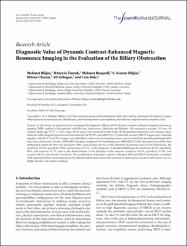Diagnostic value of dynamic contrast-enhanced magnetic resonance imaging in the evaluation of the biliary obstruction

Göster/
Erişim
info:eu-repo/semantics/openAccessTarih
2012Yazar
Bilgin, MehmetToprak, Hüseyin
Burgazlı, Mehmet
Bilgin, S. Şennur
Chasan, Ritvan
Erdoğan, Ali
Balcı, Cem
Üst veri
Tüm öğe kaydını gösterKünye
Bilgin M, Toprak H, Burgazli M, Bilgin SS, Chasan R, Erdogan A, Balcı C. Diagnostic value of dynamic contrast-enhanced magnetic resonance imaging in the evaluation of the biliary obstruction. ScientificWorldJournal. 2012; doi: 10.1100/2012/731089.Özet
Purpose. In this study, our purpose was to investigate the diagnostic efficacy of the dynamic contrast-enhanced magnetic resonance imaging (MRI) method in the patients with bile duct obstruction. Materials and Methods. 108 consecutive patients (53 men, 55 women, mean age; 55.77 ± 14.62, range 18–86 years) were included in this study. All the patients underwent conventional upper abdomen MRI using intravenous contrast material (Gd-DTPA) and MRCP in 1.5 Tesla MRI scanner. MRCP images were evaluated together with the T1 and T2w images, and both biliary ducts and surrounding tissues were examined for possible pathologies that may cause obstruction. Results. MRI/MRCP findings compared with final diagnoses, MRI/MRCP in the demonstration of bile duct obstruction sensitivity 96%, the specificity 100%, and accuracy 96.3%, in the detection of presence and level of obstruction, the sensitivity 96.7%, specificity 100%, and accuracy 97.2%, in the diagnosis of choledocholithiasis, the sensitivity 82.3%, specificity 96%, and accuracy 91.7%, and in the determination of the character of the stenosis, sensitivity 95.6%, specificity 91.3%, and accuracy 94.5% were found. Conclusion. The combination of dynamic contrast-enhanced MRI and MRCP techniques in patients with suspected biliary obstruction gives the detailed information about the presence of obstruction, location, and causes and is a highly specific and sensitive method.

















